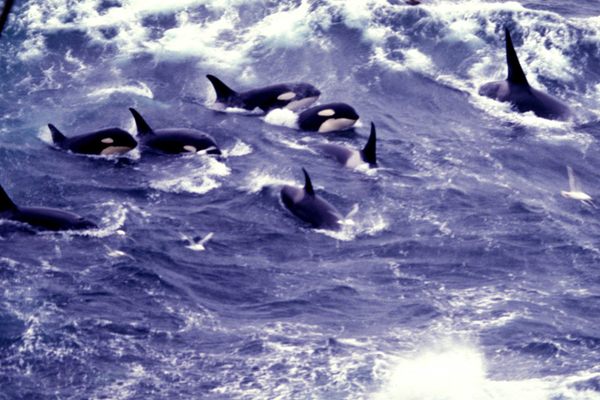How Whale Calls Change Over Time
They start out babbling, and get a lot more eloquent. Sound familiar?

When Holly Root-Gutteridge imitates an infant North Atlantic right whale, it sounds like something between a yawn, a squawk, and a boop. “You can tell what kind of call they’re trying to make, but it comes out really funny,” she says. Some sound loopy. On one recording, “one of them sounds like a burp—like a baby tried to call and burped in the middle of it.”
Humans should be able to relate to a slow slog toward articulateness. Your vocabulary has likely ballooned beyond your repertoire of infant babbles, for one thing, and you’ve got more control over your lips and tongue. By analyzing 986 calls collected from 49 individuals, Root-Gutteridge has concluded that right whales also refine their calls as they age.
As a post-doctoral researcher in biology at Syracuse University, Root-Gutteridge analyzed a trove of recordings made over a 17-year period. To collect the calls, scientists sunk hydrophones into the water, or adhered recording tags to whales’ bodies with suction cups. (These stayed on for between 12 minutes and 48 hours.) Researchers identified whales by comparing photographs of distinctive rough patches on the whales’ skin to images in a catalog maintained by the Right Whale Consortium. They then sorted the individuals into age categories: calf, juvenile, adults aged 15-25, and adults older than 25. Scientists then analyzed the calls, tracking attributes such as duration and chaos—essentially, the amount of grit, growl, and scratch that accidentally leaps out when, for instance, you strain for a note you can’t quite reach.

“In the same way that I have an individual voice and you have an individual voice, the whales do, too,” Root-Gutteridge says. Those variations tend to emerge in pitch. But broad patterns emerged, too, as Root-Gutteridge describes in a new paper published in Animal Behavior.
At first, the findings didn’t strike Root-Gutteridge as being especially surprising: “Babies tend to make baby talk, and have to learn a little bit or physically develop, in some species, to be able to make adult calls,” she says. But the picture got a little more complicated. “I was going, huh. This isn’t stopping—this is still refining as they age.” The calls changed throughout the whales’ lives, even after they’d reached maturity.
By the time they’re a year or two, whales are forming abbreviated approximations of the calls. “Instead of really long-duration ‘oop,’ they’re briefer,” Root-Gutteridge says. “As they age, the calls get longer and longer.” Younger whales’ calls were chaotic, too. Juveniles’, less so—and by the time the whales were 25, they weren’t making much of this type of ruckus at all. As they aged, Root-Gutteridge says, “whales got better at making a purer version of the sound.”

There’s a lot that researchers still don’t know, and some of that hinges on a murky picture of vocal development. The question is whether a young whale must pass a physical milestone before making a particular sound, or whether another individual just needs to model it. Beluga whales, for instance, have demonstrated vocal learning, in which young individuals are able to reproduce a call when they hear it. It’s not yet clear whether that’s how it works for right whales, too.
It’s also hard to translate the messages the whales may be volleying back and forth. Root-Gutteridge suspects that the characteristically undulating upcalls function as a sort of ping—a “Marco Polo kind of, ‘I’m here, where are you?’” Pinning down anything more specific is “a major problem in animal communication, trying to figure out how to record the sounds under natural conditions, and do it often enough to be able to say, ‘This was always made when they did this,’ or, ‘Every time they made this call, they drew another whale to them, which means it’s probably meaning something like this.’”
Since researchers weren’t watching the animals while they wore the acoustic tags, they can’t be sure of what the whales were up to. Many cetacean researchers spend hours squinting out into the distance, watching for plumes of water, a shadowy shape, or the gentle rise of a back. If the whales have dived deep—or if the calls happen to be emitted at night—researchers don’t know whether the whales were feeding, swimming, or resting. To better understand the relationship between behaviors and vocalizations, Root-Gutteridge says researchers would need thousands of calls matched with data from visual observations. A stronger data set would also include more male whales, and fill in some ages that are missing.
Meanwhile, other experts suggest that the window to study these whales is slamming shut. There are only a few hundred of this baleen species left in the wild, lumbering through the waters on the East Coast of the U.S. and Canada, and researchers haven’t recorded any new births this year. “When you have high mortality and zero reproduction, it’s catastrophic,” Michael Moore, director of the Marine Mammal Center at the Woods Hole Oceanographic Institution, told the Boston Globe. “It couldn’t be any worse.” The whales can die when they’re ensnared in fishing nets or other equipment, and warming waters have been correlated with a steep decline in the plankton that they feed on. Speaking to The Guardian earlier this week, a researcher at Woods Hole Oceanographic Institution warned that the species could be extinct by 2040. If researchers are going to hold a microphone to the ocean, better sooner than later.
























Follow us on Twitter to get the latest on the world's hidden wonders.
Like us on Facebook to get the latest on the world's hidden wonders.
Follow us on Twitter Like us on Facebook